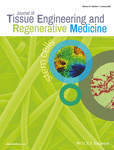Validation of an implantable bioink using mechanical extraction of human skin cells: First steps to a 3D bioprinting treatment of deep second degree burn
Abstract
Clinical grade cultured epithelial autograft (CEA) are routinely used to treat burns covering more than 60% of the total body surface area. However, although the epidermis may be efficiently repaired by CEA, the dermal layer, which is not spared in deep burns, requires additional treatment strategies. Our aim is to develop an innovative method of skin regeneration based on in situ 3D bioprinting of freshly isolated autologous skin cells. We describe herein bioink formulation and cell preparation steps together with experimental data validating a straightforward enzyme-free protocol of skin cell extraction. This procedure complies with both the specific needs of 3D bioprinting process and the stringent rules of good manufacturing practices. This mechanical extraction protocol, starting from human skin biopsies, allows harvesting a sufficient amount of both viable and growing keratinocytes and fibroblasts. We demonstrated that a dermis may be reconstituted in vitro starting from a medical grade bioink and mechanically extracted skin cells. In these experiments, proliferation of the extracted cells can be observed over the first 21 days period after 3D bioprinting and the analysis of type I collagen exhibited a de novo production of extracellular matrix proteins. Finally, in vivo experiments in a murine model of severe burn provided evidences that a topical application of our medical grade bioink was feasible and well-tolerated. Overall, these results represent a valuable groundwork for the design of future 3D bioprinting tissue engineering strategies aimed at treating, in a single intraoperative step, patients suffering from extended severe burns.




